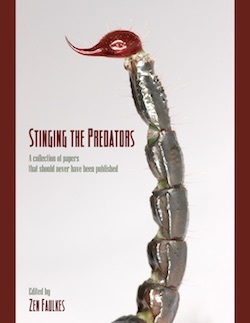Marc Abrahams's Blog, page 212
August 21, 2017
Cover image orientation in celebrity cookbooks (new study)
If you a reader, collector, participant, or are in any other way connected to, or interested in Celebrity Chefs’ Cookbooks you may have found yourself wondering whether the chefs pictured on the book covers predominantly tend to present their right cheek to the camera or their left cheek?
In that case, thanks to of the Department of Psychology and Counselling, La Trobe University, Melbourne, Australia, you now have information at hand to assist your research.
“Celebrity cookbook covers (N = 493) were sourced online; identity, portrait orientation, photo type, and sex were coded. For celebrity cookbooks, left cheek covers (39.6%) were more frequent than right cheek (31.6%) or midline covers (28.8%); sex did not predict pose orientation.”
See: Celebrity chefs put their left cheek forward: Cover image orientation in celebrity cookbooks in the current issue of Laterality: Asymmetries of Body, Brain and Cognition, Vol 25, 2017, issue 5.
* Note: “Only cookbooks available in hardback or paperback were sampled. Self-published eBooks were excluded: a chef without the media attention and publicity needed to garner a publication deal is, by definition, not a celebrity chef.”

August 17, 2017
Shocking rice pudding technique (report)
“Currently, consumers’ concerns and consciousness about safety and nutritiousness of food consumptions are increasing. Fresh and fresh-like products have become more attractive in the market than the same kind of products produced by heat process.”
But heating isn’t the only method to preserve, say, rice pudding – you could pulse 33,000 volts though it instead. A joint US / Turkey / Thai investigation in 2008 did just that – with promising results. The team developed their own rice-pudding recipe (see diagram) and then exposed it to Pulsed Electric Field (PEF) treatment – the results of which showed that the pudding’s shelf life could be considerably extended whilst maintaining its fresh-like appearance.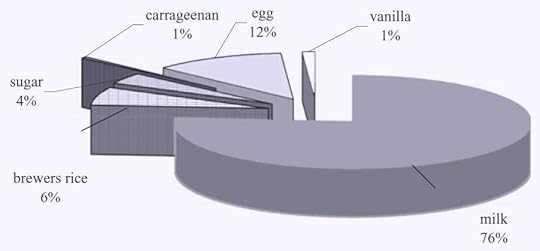
See: PULSED ELECTRIC FIELD PROCESSING OF FORMULATED RICE PUDDING by P. RATANATRIWONG, G. AKDEMIR EVRENDILEK and Q.H. ZHANG in the Journal of Food Safety, 28, (2008) 126–141.
Notes:
• The diagram above is a pie chart of a rice pudding.
• The research project was funded by the U.S. Army Natick RD&E Center.

August 14, 2017
Ig Nobel ceremony on September 14 ( One month from today!)
The 27th First Annual Ig Nobel Prize Ceremony will happen on Thursday evening, September 14.
A few tickets (most of them in the back rows of the balcony) are still available.
The Harvard Box Office handles all ticket sales. The physical ticket office [now in a temporary location in Farkas Hall, 10 Holyoke Street, Cambridge] is open some (but not all!) days from noon to 6 pm. Telephone (+1) 617-496-2222.
The web site is open 24 hours, every day.
Tickets: $75 / $65 / $55 / $35
Student tickets: $70 / $60 / $50 / $30
Ig Glorious tickets: $150. We fund the ceremony (theater rental, and half a zillion other expenses) mainly through ticket revenues. We are offering a few special “Ig Glorious” tickets, for persons who want to be specially supportive. Ig Glorious tickets come with special perks: Excellent seats; A vintage copy of the Annals of Improbable Research, signed by an emissary; Their photo taken at the Ig Nobel lectern on stage (before or after the ceremony, at the discretion of the Stage Manager); Access to our Ig Glorious Liaison, a staff member assigned to the “Ig Glorious” group for the entirety of the event; And a hearty handshake!
THE CEREMONY
WHERE: Sanders Theatre, Harvard University
WHEN: THURSDAY, SEPTEMBER 14, 2017, 6:00 pm.
Ceremony details.

Shocking Mushrooms Technique (report)
“The SPLG [pictured above] consists of four parts: a controller, connection cable, a high voltage generator, and a wheel electrode. The system is powered by rechargeable AA sized batteries. Lightening [sic] is generated by an epoch-making device which can be disassembled and used elsewhere.”
The epoch-making lightning dispenser was developed by Ferzana Islam and Shoji Ohga at the Department of Agro-Environmental Sciences, Faculty of Agriculture, Kyushu University, Japan, and is intended to give high voltage electric shocks to mushrooms – specifically Shiitake (椎茸) mushrooms.
“After applying the electric stimulator to the specific area, the numbers of mushroom were increased more than twice. Remarkable changes were also observed by weight gaining of the fruit bodies which increased 67% in the first harvest and 69% in the second harvest, and besides length was increased by 65 to 113%. [pictured below]”
 In their report, the team didn’t speculate about why giving the mushrooms electric shocks might make them grow faster and bigger, other than to note :
In their report, the team didn’t speculate about why giving the mushrooms electric shocks might make them grow faster and bigger, other than to note :
“ As the mechanism of fruit body formation is not still fully understood, it needs further more research work.”
See: The Response of Fruit Body Formation on Tricholoma matsutake In Situ Condition by Applying Electric Pulse Stimulator in ISRN Agronomy, Volume 2012 (2012), Article ID 462724.
Coming Soon: The effects of high voltage electric shocks on rice pudding.

August 10, 2017
Slowing down ping pong for TV (study)
“The medial [sic] appeal of table tennis seems to go down in terms of TV hours, at least outside Asia. One of the reasons is the fact that the speed of the game is nowadays so high that it is very hard for spectators to follow the balls.”
So, in terms of slowing down the game (in order to increase its appeal for TV viewers) what might be done? In 2013, a team from the Institute of Physics, and the Institute of Community Medicine at Ernst-Moritz-Arndt University, Greifswald, along with the Faculty of Informatics and Electrical Engineering, University Rostock, Germany, decided to use a computational modeling approach to provide answers.
“
An Euler solver was used, because its algorithmic simplicity allowed an easy transfer onto the GPU with CUDA. A commonly used Runge-Kutta algorithm was not chosen, because it has larger computational costs. A fourth order Runge Kutta approach needs to calculate four times the forces, which slows down the code performance in our case compared to the simple Euler method. This was not compensated by the larger time step possible with the Runge-Kutta method compared to the Euler method. The dependence of the aero dynamic forces on the velocity also does not allow the use of a Verlet algorithm. Therefore, we decided to stay with the Euler method.”
The results revealed not one, but two possible methodologies which could be practical solutions – if adopted by the International Table Tennis Federation (ITTF).
“A larger ball of 44 mm with small weight is one option for suppressing high velocities, resulting also in a reduction of the influence of spinning. As an alternative option an increase of the net height is possible.”
See:’ Computer simulations of table tennis ball trajectories for studies of the influence of ball size and net height ‘ in the International Journal of Computer Science in Sport, volume 12/2013/edition 2.
Bonus Task [optional] Suggest other methods that might be employed to slow down the game.
Also see: Things researchers do with ping-pong balls
Note: The illustration is an interesting candidate for the Necker cube illusion. (stare at it for a while and it will probably flip)

August 8, 2017
Soap Film Opera, fluid dynamically, in France
A series of musico-visual treats — in a new genre called “soap film opera” — are being produced by Florence Elias and her colleagues at Laboratoire Matière et Sytèmes Complexes, Université Paris Diderot and at CNRS. The genre marries soap film, fluid dynamics, music, and videography. Here are three samples — “Habañera” from Carmen, “Lucilla”, and “The Good, the Bad, and the Ugly”:

(Thanks to Nicole Sharp of FYFD for bringing this to our attention.)

Scientist who uplifted a frog did not support the Chinese brassiere
News reports say that Andre Geim (who won an Ig Nobel physics prize for using magnets to levitate a frog, and then won a Nobel physics prize for discovering how to obtain and study the virtually-two-dimensional form of carbon known as “graphene“) — discovered that a Chinese brassiere manufacturer is falsely claiming that he, Andre Geim, endorsed the power of their brassieres.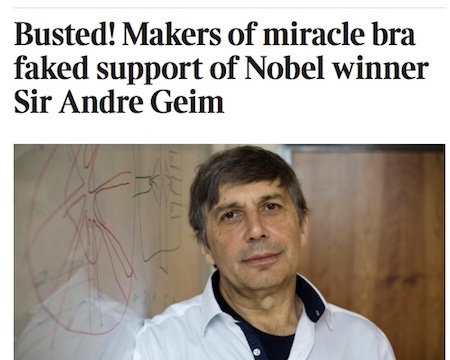
The Times report begins:
Busted! Makers of miracle bra faked support of Nobel winner Sir Andre Geim
Graphene scientists are used to dealing with exciting claims. The material’s superconductivity could revolutionise electronics and its super-strength could transform aircraft construction. Few industries appear safe from disruption.
Even so Andre Geim, who won a Nobel prize for its discovery, was surprised to hear graphene underwear could renew sexual vigour and enlarge breasts. He was particularly surprised because, when he read about the claims, they were endorsed by one Professor Andre Geim, from the University of Manchester….. Shengquan insists underwear made of graphene boosts breast size and sex lives….
The South China Morning Post carries this headline on its report:
‘I’m not advertising underwear’: UK Nobel laureate in ‘fake claims’ row with Chinese firm
(Thanks to Davide Castelvecchi for bringing this to our attention.)
NOTE: So far as we are aware, the Shengquan bra is not connected in any way with the Emergency Bra (a brassiere that, in an emergency, can be quickly converted into a pair of protective face masks, one for the brassiere wearer and one to be given to some needy bystander.), whose inventor, Elena Bodnar, was awarded an Ig Nobel Prize for public health….

August 7, 2017
Can trends in baby’s names foreshadow major social events? (new study)
“Before 1992, the names ‘Hillary’ and ‘Hilary’ had been increasing in popularity for several decades. After 1992, however, their popularity dropped suddenly 10-fold.”
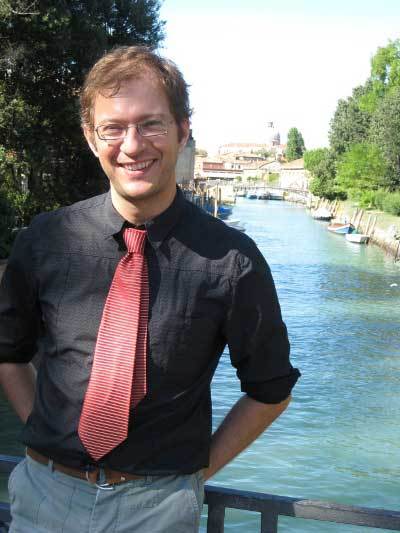 – explains Stefano Ghirlanda who is Professor of Psychology, Biology, and Anthropology, Brooklyn College, CUNY, and Founder and fellow, Centre for the Study of Cultural Evolution, Stockholm University. With this in mind, he writes, in the current issue of Cliodynamics: The Journal of Quantitative History and Cultural Evolution regarding his thesis that : ‘Trends in First Names Foreshadowed Hillary Clinton’s Electoral Defeat’
– explains Stefano Ghirlanda who is Professor of Psychology, Biology, and Anthropology, Brooklyn College, CUNY, and Founder and fellow, Centre for the Study of Cultural Evolution, Stockholm University. With this in mind, he writes, in the current issue of Cliodynamics: The Journal of Quantitative History and Cultural Evolution regarding his thesis that : ‘Trends in First Names Foreshadowed Hillary Clinton’s Electoral Defeat’
“I examine trends in the popularity of first names around the years of USA presidential elections, showing that the names ‘Hillary’ and ‘Hilary’ decreased abruptly by more than 90% in popularity following the 1992 election of Hillary Clinton’s husband Bill. I show that this outcome is unique to the 1992 election, and argue that it may evidence a “dislike” for Hillary Clinton’s public image among both Democratic and Republican voters, which may have eventually contributed to Hillary Clinton’s losing the 2016 presidential election.”
Bonus Task [optional]: At the time of writing, according to the US Govt. , the most popular boy’s name is ‘Noah’. What, if anything may be inferred?
Update Note: Professor Ghirlanda was co-recipient of the 2003 Ig Nobel prize for INTERDISCIPLINARY RESEARCH (along with Liselotte Jansson, and Magnus Enquist of Stockholm University), for their inevitable report “Chickens Prefer Beautiful Humans.”

“All these papers were deliberately bad”
“All these papers were deliberately bad. They were created with the purpose of exposing exploitative publishing practices. That is, the works collected here were sting operations on predatory journals.” So says the introduction to the book Stinging the Predators: A collection of papers that should never have been published, assembled by Zen Faulkes. Falkes is a professor of biology at the University of Texas Rio Grande Valley. You can download the book, free.
That book includes the following papers, and follows them with some Faulkesian analysis of the situation that led people to write the papers, and led publishers to publish them:
The blog that called predator (June 2009)
Abstract theology (August 2011)
Random math (September 2012)
The Bohannon Science sting (October 2013)
“Get me off your fucking mailing list” (November 2014)
Cuckoo for cocoa puffs (January 2015)
Fake news (May 2015)
Been there, done that (August 2016)
“Siri, write me a conference abstract” (October 2016)
The first Spears (November 2016)
The second Spears (December 2016)
Doctor Fraud (March 2017)
A paper about nothing (April 2017)
The conceptual penis (May 2017)
The garbage’ll do (July 2017)
Spam inspires surreal sting (July 2017)
NOTE: Publication of the Sokal hoax paper led to the awarding of the 1996 Ig Nobel Prize for literature to the editors of the journal Social Text, for eagerly publishing research that they could not understand, that the author said was meaningless, and which claimed that reality does not exist.

August 3, 2017
“Ingredients in Victoria’s Secret Bombshell and Ivanka Trump eaux de parfums that repel mosquitoes” [research study]
Humanity’s war against mosquitoes still rages, after the failure of another new strategy. This study gives details:
“Ingredients in Victoria’s Secret Bombshell and Ivanka Trump eaux de parfums that repel mosquitoes,” Fangfang Zeng, Pingxi Xu, Kaiming Tan, Paulo Zarbin, Walter Leal, BioRxiv, August 3, 2017, doi.org/10.1101/172304. The authors, at the University of California Davis and Universidade Federal do Paraná, Brazil, report:
“We analysed Bombshell to identify the constituent(s) eliciting a previously reported “off- label” repellence activity…. These compounds were also major constituents of Ivanka Trump eau de parfum…. Although wearing these perfumes may repel nuisance mosquitoes, their use as “off-label” repellents against infected mosquitoes is not recommended…. A panel of 104 students (18-23 years old) conducted a blind test to compare the two eaux de parfums and showed a preference for Bombshell over Ivanka Trump’s brand, particularly among women.”
Here’s additional detail from the study:
This is the standard container for Bombshell perfume:
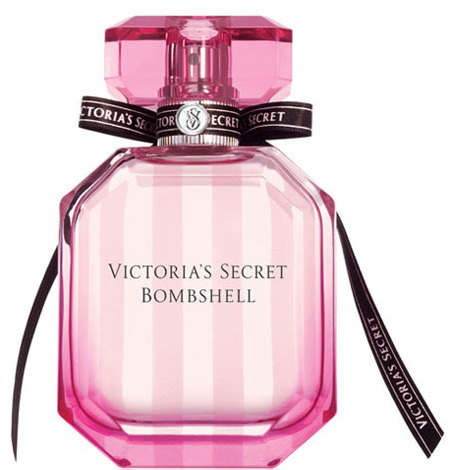
(Thanks to Dan Vergano for bringing this to our attention.)

Marc Abrahams's Blog
- Marc Abrahams's profile
- 14 followers





